Granada and Alhambra
2 March, 2008, 12:02 am in "Spain"
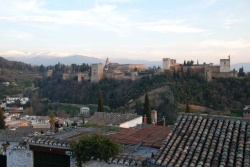 Descending through the mountains to Granada at sunrise was pretty but didn't improve my mood much after a sleepless bus ride from Barcelona. My mood did improve, however, as I walked though silent, twisting streets past Moorish architecture, looking for a place to stay. The situation was hopeless until after noon but at least I had a chance to enjoy the peaceful streets before they became thronged with people. One place offered to store our bags until a room was available at 2 PM.
Descending through the mountains to Granada at sunrise was pretty but didn't improve my mood much after a sleepless bus ride from Barcelona. My mood did improve, however, as I walked though silent, twisting streets past Moorish architecture, looking for a place to stay. The situation was hopeless until after noon but at least I had a chance to enjoy the peaceful streets before they became thronged with people. One place offered to store our bags until a room was available at 2 PM.Rowshan and I eagerly began exploring the town. One street took us alongside a stream below the Alhambra. A stone bridge arched over it.
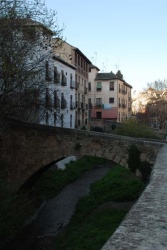
We wandered into a garden of one building and then up the hill through the Moorish quarter, noting keyhole arches and beautiful ceramic and stone ornamentation.
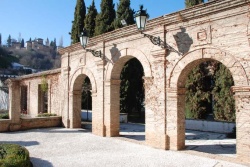
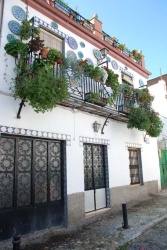
The atmosphere was very peaceful and relaxed with whitewashed walls and fruit trees.
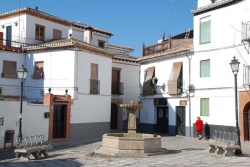
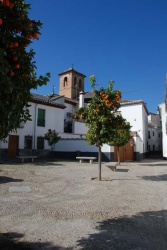
We found a couple different viewpoints from which we could see the Alhambra against a backdrop of snow blanketed mountains.
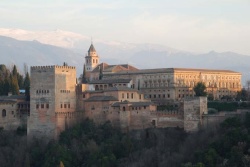
By this time things were getting crowded. At the St. Nicolas viewpoint, a chaotic blend of neo-hippies selling jewelry or busking and tourists, lounged admiring the view and the atmosphere.
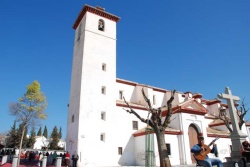
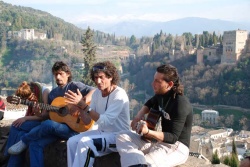
There was a flamenco band who set the mood.
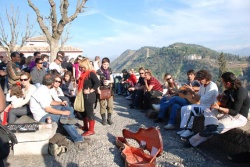
After all, Granada is considered the birthplace of flamenco. We briefly took a walk along the Sacremonte Road, passing flamenco bars and cave houses where the Roma people had settled and created bars for flamenco music and dance.
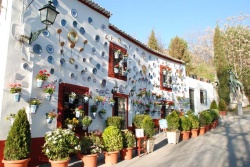
Then we returned to the viewpoint to admire the sunset.
From the distance, the Alhambra, though beautiful, still looks like other European Medieval fortresses. The only hints of its Islamic origins are an occasional window or arch where the telltale keyhole shape is visible. Our first glimpse of the Alhambra close-up was of the walls and a purely Islamic ornate gate. Rowshan said as soon as he saw it he expected an army of Moorish horsemen to come pouring through it.
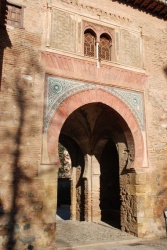
Soon we left the stone exterior and entered the lace-like interior of the Nasrid Palaces. Everything about the inside of the palaces makes one want to stop and look. From the first doorway it draws you into an incredible world of decoration. In the first room I started felling overwhelmed.
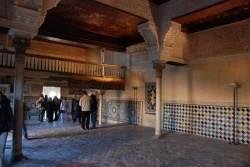
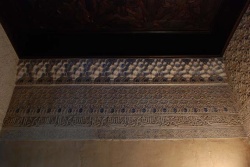
Our tickets only allowed us half a day in the Alhambra and it would take ages to absorb everything. There are geometric tile mosaics in yellow, blue and green and lots of intricate gesso work consisting of Kufi calligraphy and tezhip floral patterns.
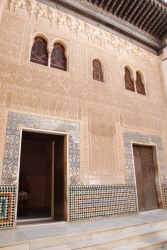
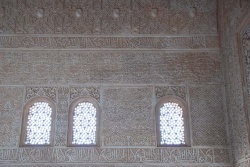
The columns have ornate capitals which resemble an optical illusion of arches rising into more arches, all dripping with lace-like gesso work.
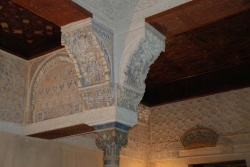
The ceilings contain patterns in wood. There are also beautiful ornate arched windows that draw the eye to tranquil gardens below.
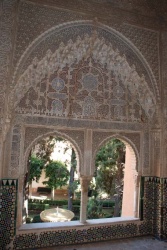
I guess at one point all the gesso would have been painted but now it is cream colored and shiny so it looked like ivory.
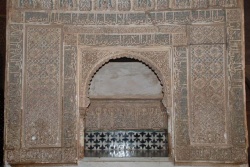
Above each doorway there was a passage from the Koran or names of the prophets, martyrs and their families, written in beautiful calligraphy and surrounded by patterns and flourishes.
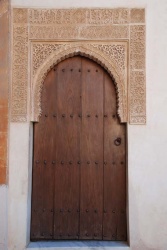
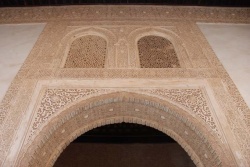
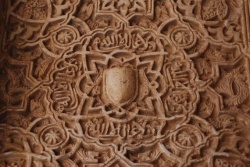
Birds had nested in some of the lace like designs above the doorways to the courtyard.
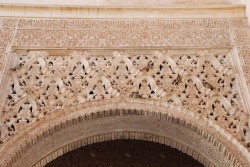
In the center of one of the palaces there was a beautiful reflecting pool.
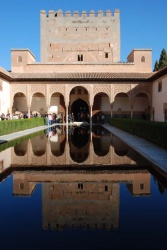
It is hard to write about the Alhambra because words don't give it credit. The photos I'd seen hadn't prepared me for it either. I found myself wondering, as a designer, how it all could work. How can so many different patterns not drive the eyes mad? Why does it make me feel calm instead of frantic? Why is it so beautiful? The decorations seem to pull the eye upward and perhaps that is the calming effect-- lifting the viewer out of the mad crowd of awestruck visitors, into a pattern like shifting clouds.
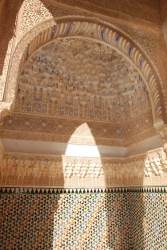
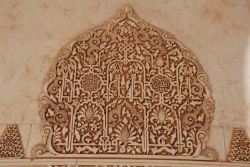
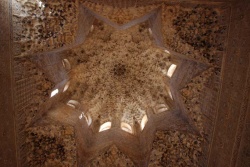
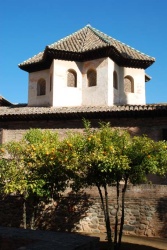
The other parts of the fortress were rather dull after seeing the palace. However, the Generalife Palace had some nice features, views and gardens.
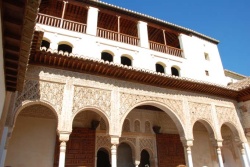
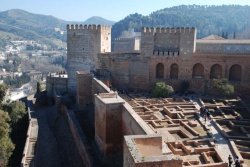
We spent the rest of our visit to the complex wishing we had stayed longer in the Nesrid Palaces... longing to go back but knowing we couldn't since our ticket only allowed us to enter it during a half hour window.
In the afternoon we took a walk up Sacremonte where we passed some newer cave houses where people were living. Then we descended into a garden and, after all our walking, Rowshan was relieved to soak his feet in a fountain.
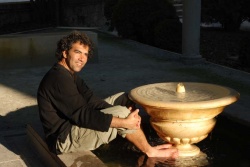
Later while walking around another part of town, we unexpectedly came upon a familiar statue, Rodin's Thinker.
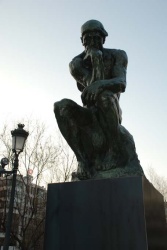
Beyond him were a bunch of other Rodin bronzes that had been installed in the center of town for a temporary exhibition. Then we noticed the setting sun was casting a golden light on some church steeples. A closer look brought us to a promenade with cafes and a bandstand where people were learning how to tango. There was also a fountain featuring Rowshan's favorite fruit, the pomegranate.
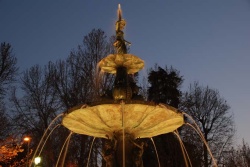
He had been dismayed to notice around the town, a couple trees where pomegranates had been left untouched on branches until they spoiled. I guess there are no Persians in Granada.

Gaudi: Forests of stone
28 February, 2008, 12:36 am in "Spain"
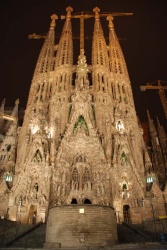 I first saw the Cathedral of the Sacred Family about 14 years ago. I remember that I just walked around it staring at the exterior in complete amazement. When Rowshan and I visited it this trip we also walked around it in complete amazement. They have done a lot in 14 years but it still isn't finished. In 1994 they had the Nativity side finished but were working on the towers on the Passion side. The cathedral felt compact but very tall. Now there was a new part jutting out to one side, its white stone bright next to the old sections where the stone had weathered to a golden color.
I first saw the Cathedral of the Sacred Family about 14 years ago. I remember that I just walked around it staring at the exterior in complete amazement. When Rowshan and I visited it this trip we also walked around it in complete amazement. They have done a lot in 14 years but it still isn't finished. In 1994 they had the Nativity side finished but were working on the towers on the Passion side. The cathedral felt compact but very tall. Now there was a new part jutting out to one side, its white stone bright next to the old sections where the stone had weathered to a golden color. The Nativity side, which had been created while Gaudi was still alive, is a riotous wall of life.
It is as if all nature, trees and rock included, and humankind flew onto the side of the cathedral to celebrate the birth of Jesus. There are flowers, lizards, snakes, frogs, and chickens as well as the traditional donkeys and sheep.
In the museum it was written that Gaudi had used the animals wandering onto the cathedral site as models. The 2 entrance pillars are supported on the backs of a sea and land turtle.
The structure of the cathedral has windows and some vaults that look like a Gothic cathedral but other characteristics are pure Gaudi: the tall towers like fir trees and the mosaic pin wheels on the top. The current entrance is on the opposite side, the Passion. This side is comparatively stark and sombre.
Instead of traditional columns, column like structures swoop from the ground to the cathedral face creating an open but protected area like a cave. The wall has clusters of geometric, cubist inspired sculptures by the artist Subirachs.
The transition from the organic Nativity to the stark passion is a bit of a shock but as I began examining the different sculptures, I was struck by their appropriateness as well as how powerful they are. The scenes include The Last Supper, Peter's Denial of Christ, the Scourging and Crown of Thorns, and Judas' Betrayal with the Roman soldiers hiding behind a tree-like column. The central scene is Veronika holding the veil she had wiped Christ's face with with the impression remaining in it and Jesus stumbling under the cross.
The sculpture of Veronika had no face but the other human faces were gaunt and showed pain, grief or aggression.
I felt like it was the figure of Peter's Denial which really brought me to an understanding of the work. Peter is hunched in front of a group of people talking and a rooster crowing. In his robes, he is heavy with grief. His face is tragic and every curve of the figure seems to evoke guilt and grief at the knowledge that he has betrayed the one he loves the most.
When I saw this, I saw all the figures as caught in the inescapable pull of fate and the human condition which cast them out of an innocence of the Garden of Eden where they lived as part of nature... also perhaps represented in the Nativity side, into a cold modern world of betrayal, senseless murder, guilt and grief. The only animals on this side are the rooster, a dog, and the snake which represents Satan by Judas. Though the geometry of the wall suggested trees, the only figurative plant sculpted was the stump of a tree. In the center of the entrance was a pole with Jesus tied where he was flogged. which we passed when we entered the cathedral. Inside is definitely not finished. It is interesting to see the work being done. The center is a workshop for mosaicists, mold makers and sculptors.
There was a display on the types of rock used and a display on some of the geometry involved in the columns and vaults. These were Gaudi's forests with columns based on the geometry of trees and innovative vaults like palm leaves arching overhead.
There was some mosaic work completed which filled the vaults with gold and orange tiles. We then took the elevator up to the towers from which we were able to walk up and down stone spiral stairs and view some of the work on the central part of the roof as well as some features of the Gloria side--mosaic walls and towers with mosaic piles of fruit on the top.
In the downstairs crypt we were able to see plaster models, an exhibit on the sculptor who designed the Nativity sculptures, sketches for the Passion sculptures, and large images of how the finished cathedral would look. There was an exhibit on how Gaudi was influenced by nature as well of some of his architectural sketches. The original sketches for the cathedral disappeared during the Spanish Civil War when his studio at the cathedral was burned and many of the original plaster models smashed.
Back outside we walked around the cathedral again. Rowshan said he thinks it will be one of the Wonders of the World when it is finished. I believe it will be the last work of its kind completed. Buildings that take more than 100 years to build are a thing of a past. Though it was started as a cathedral of redemption, it has also become a cathedral to art.
We walked back to the center via a couple more Gaudi creations: Casa Mila (La Pedra),
where we visited an exhibition and were able to glance into the courtyard, and Casa Batlo with its fantastic roof.
As we wandered around Barcelona, we made a point of visiting other Gaudi creations including Finca Guell with its magnificent dragon gate.
Another fabulous Gaudi work is Parc Guell. We approached from the back where a series of escalators took us up the hill to the entrance. We headed down to the popular part of the park with its rock grotto arches, long curving mosaic bench and the columned grotto underneath: a space I found enchanting with its thick round columns and glass and mosaic ceiling pieces.
A guitarist was playing classical music with a crowd of children sitting quietly enraptured by the music. The teachers practically had to drag 2 of them away and encourage them to run screaming all over the park instead. The "dragon" which I think is actually a lizard, was as popular as ever with everyone posing with it, a huge frustration for Rowshan who just wanted a photograph of the lizard by itself.
The park had many other Gaudi details: ceramic pieces broken and made into convex curved motifs on the walls, whimsical soft serve ice cream towers and areas where the border between what was nature and man made blurred.
There were lots of buskers and sellers. We tested out the curving bench which we found quite comfortable.
[ View 3 Comments
|
]
Barcelona: Gothic Architecture and Soccer
27 February, 2008, 10:47 am in "Spain"
We are staying in the center of the old town, an area of narrow streets and Gothic buildings. We spent yesterday wandering around looking at the interesting things that presented themselves. Off of one square, a cobblestone street led past art shops, by a Gothic structure with gargoyles under an ornate bridge.
Most of the time we didn't have any idea where we were going. We just walked and when we saw something interesting we'd head toward it. Somehow we ended up at The Cathedral. We walked into the courtyard which, unlike any church I've been in, felt like a forest. Huge palm trees filled the center and there was a very moss filled fountain which doubled as a goose pond for a flock of white geese.
There was even a little goose house. The area felt a bit warmer and more humid than the street outside. The church itself also reminded me of a forest.
It had tall columns reaching to the ceiling and delicately carved points and plant like filigree in the wooden choir area.
It made me wonder if this cathedral had any influence on Gaudi's Sagrada Familia which is meant to be a forest. Some more modern additions were electric votive candles which would light up if you put a coin in the box
as well as a coin operated light for the chapel underneath the alter which held the sarcophagus of a saint.
We continued walking until we reached Las Ramblas, a busy street with a pedestrian part in the center filled with cafes, artists, and guys doing shell gambling games.
There were also an annoying number of human statues.
A short walk from the main square we saw a triumphant arch which I recalled seeing before when I noticed the bat decorations.
Later in the evening we stopped by the open air market which was a bit cleaner and glitzier than the markets of South America. We were especially impressed by the perfectly stacked fruits of one vendor.
Since it was almost closing time we managed to score some cheap fruit juices.
On the day of the match we stopped by the stadium around lunch time to see which metro station was closest to our entrance. There we saw a crowd of people waiting by the parking lot exit. I guess it was time for the team to take a lunch break from their morning practice. We walked into the Barcelona Mega-Store, a 2 story temple to Barcelona paraphernalia ranging from standard jerseys to a Barca refrigerator.
You could also have your photo digitally enhanced so it looked like you had a photo with the player of your choice. We found socks on sale (2 pair for 4.95 euros) which we bought since we needed socks.
As we left the store we noticed the crowd had gotten bigger. We joined them in time to see the team members walk from the stadium, about 10ft to the bus and hear the crowd go completely mad.
In the evening we arrived at the stadium early along with other foreigners and out-of-towners who didn't know what time the stadium opened. We wandered around then hung out at the gate while groups of Valencians voiced and showed their support for their team. Finally we were let in.
Valencia had a large contingent and they filled a corner of the stadium singing their team song and waving flags.
We had a small group near us but they soon migrated to the Valencia corner. Another couple guys rolled up their flag when threatened by some Barcelona fans.
I have to say even though we both like Barcelona, we found that Valencia had better fans. Where they sang songs and cheered, the Barca fans just chanted obscenities about Valencia. Valencia scored a goal but Barca had the ball most of the time and had the most chances to score. We left 5 minutes early to try to catch the last metro (the game started at 10 PM and went to midnight). When we were about a block from the stadium, we heard a loud cheer. A passing driver said Barca finally scored in the last minute. Oh well. We were relieved to catch the last metro and not have to figure out (and crowd onto) the limited night buses.
Powered by My Blog 1.69. Copyright 2003-2006 FuzzyMonkey.net.
Created by the scripting wizards at FuzzyMonkey.net..
(Code modified by Rowshan Dowlatabadi)
Created by the scripting wizards at FuzzyMonkey.net..
(Code modified by Rowshan Dowlatabadi)

